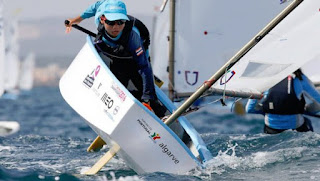A note about those "spin-off classes offering a home to those not at the front end of the Optimist circuit"
 |
| The RS Tera - one of the alternatives to the Optimist |
I think that things are much more complex than that regarding U16 youth sailing. Conventional thinking is that the Optimist is the best / only worthy path. It’s the naïve approach that many people, many parents, many clubs, many federations, fall for, not knowing the details about what competitive Optimist sailing is.
The reality is that it is extremely difficult to develop top Optimist sailors. For several reasons. First the boat is complex, unnecessarily complex for boys and girls being 10,11 and 12, and who spend considerable amount of time learning for example how to rig the sail, adjust the sail ties, etc. All of this is overly complex indeed for such young sailors. Second, there is the question of equipment. Once the sailor becomes competitive, top notch equipment is needed, and for many parents and coaches, and obviously sailors, that’s knowledge that is not that obvious to get. There are many models of masts, booms, sprits, rudders, daggerboards, hulls and sails to choose from, and the right combination evolves while the sailor grows and gains expertise. Third, the Optimist requires massive amounts of coaching, because of the complexity of the boat, the tunings, the equipment choices, the fact that many settings need to be done on shore and are hard to adjust on the water if conditions change. There is an acute shortage of top level coaches in many countries. And you also need a club or a national team or something similar with top level training buddies, year round, and it's clearly better to have this in a windy location. And then comes the financial issue. Among the top performers, there can be considerable spending involved. It’s not unheard that some parents will spend 6 digit figures per year, in dollar terms, on Optimist sailing. In some cases, there is some help from the federations, but that’s not at all the case everywhere.
Oh I forgot, you have to pray for your kid not to grow too fast, because once the weight of 100 lbs is reached, it will become more difficult to be competitive. And above 110 lbs, you just need to say bye bye to the boat or pray for 20 + knots. Of course, you need an athletic, hard working, talented sailor, but you also need all these conditions to be met. There are just a few countries that are able to foster such conditions for top Optimist sailing. At the last worlds in Cyprus, there were just 3 countries with their 5 sailors in the gold fleet: Italy, Israel and Thailand. And another two countries, Brazil and Switzerland, with 4 out of their 5 sailors in the Gold Fleet. Many countries are struggling. For example, only one sailor from the UK - a country where youth sailing is being taken extremely seriously - made it to the silver fleet (127th overall), none made it to in the gold fleet.
In other classes, such as the Tera, the Open Bic and the double-handed Feva, things can be much simpler. For example, the Open Bic is a strict one design. No arms race for equipment. Much less boat specific intricacies, i.e. many more suitable coaches. There is then more focus on strategy and tactics, which are obviously transferrable in the next boat. The boat is much more affordable, and it is sturdy, and is therefore ideal for club owership, which improves access to sailors from less affluent families. There is a more affordable circuit, in terms of entry and charter fees, and no requirement to use the hotels mandated by the class. And one can remain competitive in the boat up to approx. 120 lbs, which adds about one year in the boat before moving to another equipment. For what it’s worth, note that the 2017 and 2018 Optimist World Champion made just a 13th position at the 2017 Open Bic Worlds, which were in Garda.
Talking about Garda, this is the location of the largest Optimist regatta in the world. Over thousand participants. There are other very large regattas, particularly in Europe. Contrast this with the Opti worlds. There are just 5 slots per country at the Optimist worlds, irrespective of the size of the country or the number of Optimist sailors in the country. And these 5 slots are for both boys and girls. This is overly restrictive, and unfair for the sailors from countries with big Opti fleets.
So having other classes such as the Bic, the Tera and the Feva helps create more opportunities for youth sailors to experience world class events. These other classes are not lesser classes. They usefully complement the Optimist. And they are producing top quality sailors too. Think for example about Titouan Petard, from France. He is a former Open Bic World Champion and he took the silver at the 2018 Youth Olympics in Buenos Aires, in the Nacra 15.
Oh, I forgot some more. Some sailors want to continue a race and not be relegated at the back of the fleet after having capsized. And also, some sailors can do without the bailing :) Quite a few, probably about 50%, prefer sailing double-handed rather than single-handed. And some simply like a faster boat ...


